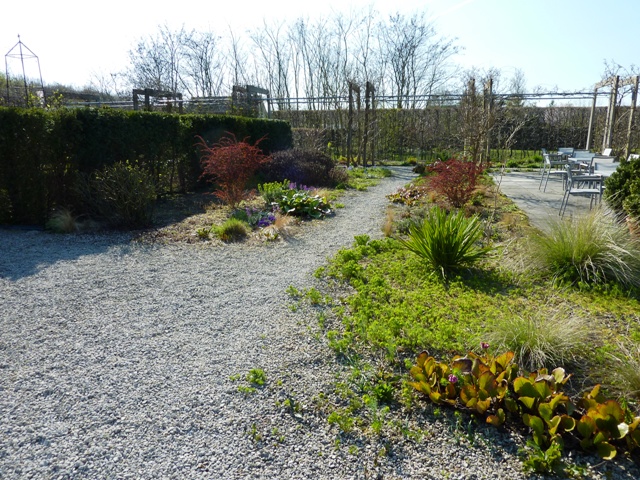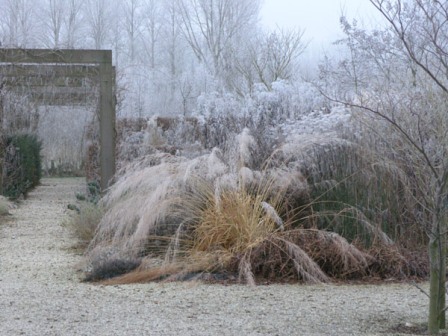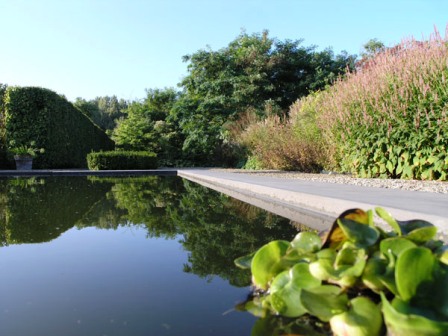 It was the end of a long day. After seeing 8 other gardens in less than 48 hours, with some long stretches of traveling time, I was ready to pack it in. Walking into a graveled courtyard with a minimalistically styled residence, an orangery with a garden shop, a narrow, rectangular pool, surrounding light colored walls and large olive trees in sunken tubs, it was easy to imagine being somewhere in the Mediterranean.
It was the end of a long day. After seeing 8 other gardens in less than 48 hours, with some long stretches of traveling time, I was ready to pack it in. Walking into a graveled courtyard with a minimalistically styled residence, an orangery with a garden shop, a narrow, rectangular pool, surrounding light colored walls and large olive trees in sunken tubs, it was easy to imagine being somewhere in the Mediterranean.
I knew that we had entered a property that would evoke a strong response.
The setting: mid- April in Holland. Twenty eight journalists from around the world had been invited by the International Flower Bulb Centre to visit private gardens in the North-Eastern part of Holland. Bulbs were blooming 2 weeks later than expected: for our sponsors, it was a matter of concern. For most of us, it didn’t matter. From the first day when we landed and rushed over to take in the scope of color, design and massive amount of bulbs at Keukenhof to our final visit to Locus Flevum, we had seen enough bulbs to appreciate how their artistry is a tightly interwoven element of Dutch gardens.
Locus Flevum is a finely honed collaboration of a married couple who live here, along with their children and parents. It is a three generation household. How wonderful is that? Jikke Hamerpagt is the garden designer and Lucien, her husband, is the architect. Jikke refers to Locus Flevum as ‘an ultra-structured garden for plant enthusiasts.’
Because so little was in bloom when we visited, it was difficult to fathom what the garden would look like in late spring, summer and fall. On the other hand, we had the opportunity to study and appreciate the bones of the garden, naked, with a minimum of flowers and foliage cluttering up its impact and strength.
In most instances when visiting a garden, my initial response stays with me. Rarely do my feelings change over time. Immediately after the visit and for at least a month afterwards, my emotional geiger counter in response to the garden was just a bit above mid-point. And yet, as time passed, I continued to return to the photos of Locus Flevum, gradually feeling as if the sky was clearing and I was seeing this garden for the first time. I was taken by surprise, questioning why, until then, I hadn’t seen the garden for what it is…provocative, edgy, beautiful and jaw dropping.
Two photos of the gravel garden, the one above in April: the one below during the summer.
Although Jikke describes Locus Flevum as modern, like most pieces of art, it encompasses some traditional elements. As soon as I came upon the gravel garden, I was reminded of Beth Chatto’s in England. And each of the garden rooms? Sissinghurst and Hidcote immediately came to mind. Each area of the garden is unique, as evidenced by the planting style and the way that Jikke defined the boundaries.
The long wisteria walkway/pergola? Magnificent, as it always is when in bloom. But what makes this one such a standout is the style of the pergola: it is clean and contemporary.In addition, the way that Jikke has positioned the pergola in relationship to the garden is unusual. She is extremely adept at taking a familiar concept and giving it a twist, with unbridled confidence and a firm vision.
How is the garden laid out? The formal pool links the patio to the garden. The first room beyond the entrance from the patio is the gravel garden, followed by the butterfly garden, the swamp, the natural pond, the orchard, the estate woodland, the shade garden, the secret garden and a variety of boldly designed gardens filled with perennials, bulbs and grasses.
One of the strengths of Locus Flevum is the flow of the garden rooms and the order in which they have been positioned. An element of a fine and satisfying dining experience is when each course segues into the next one so that your palette is neither over or underwhelmed. Constant exuberance can be exhausting. As gardeners, our visual senses need a respite from non-stop visual stimulation. Jikke has accomplished this feat in her garden. She engages us with an intense planting scheme and then allows us to cool off when we walk into the next area of the garden where it is less tightly planted up. If she had positioned the garden rooms in a different order, Locus Flevum most likely would have ended up being a choppy composition.
Modern is not the word I would choose to describe this garden; it’s too confining. Rather, Locus Flevum is a fresh, over the top, seductive and exuberant collaboration: designed and built with an enormous amount of creative energy and passion.
Photos courtesy of Locus Flevum






